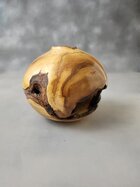I run a free wood turning program for veterans called BurlBowl woodturning. We turn mostly burls, no shocker there. What i have a problem with is when we want to finish a burl that has bark inclusions, voids holes ect and get a finish that is high gloss. Normally we use high build friction polish, we make our own shellac from flakes using 190 proof alcohol. We use yorkshire grit. Problems is friction polish tends to build up in the voids and needs to be picked out and isn't feasible. The shellac I have a problem with getting it really glossy and sometimes even with the platinum shellac it still imparts a slight yellow hue. The yorkshire grit isn't polished enough. Spray varnish? What do I do and also what is the best gloss that's also pretty tough to scratching. The best thing I have seen is the UV finishes like vesting or similiar. Please help me help the vets. thanks
-
April 2025 Turning Challenge: Turn an Egg! (click here for details) -
Congratulations to Kelly Shaw winner of the March 2025 Turning Challenge (click here for details) -
Congratulations to Guillaume Fontaine for "Nebules" being selected as Turning of the Week for April 6, 2025 (click here for details) -
Welcome new registering member. Your username must be your real First and Last name (for example: John Doe). "Screen names" and "handles" are not allowed and your registration will be deleted if you don't use your real name. Also, do not use all caps nor all lower case.
You are using an out of date browser. It may not display this or other websites correctly.
You should upgrade or use an alternative browser.
You should upgrade or use an alternative browser.
Need tips on finishing burls with voids
- Thread starter Todd Lesiege
- Start date
Spray laquer, wipe on poly. Spray laquer will yellow less than poly. Can be difficult to get a even gloss on a rough surface like burl( for me at least). I usually just go with a danish oil, not big on gloss finishes for most of what I turn.
I am becoming a big fan of Rubio Monocote. It is a slow curing oil, and most who use it will apply 2 coats. Many are now adding a "ceramic" top coat that comes from the auto industry. The problem with penetrating oils is bleed out where you get spots all over the piece, especially burl, which can be steel wooled off, or I hit the piece with an air nozzle. Rubio is pretty expensive for the size of container you get, but a tiny bit goes a looooong way!
robo hippy
robo hippy
Option 1. Wipe-on oil base poly works well. I do many (~10) thin coats, wiping on and wiping off most of it. And sanding after about 3-5 coats. Option 2 Danish oil or your own homemade mixture of BLO, poly and thinner. Some people soak it in heavily and then wipe off the excess after 15 minutes. Others do more thin coats. Option 3. A hardwax oil. I have used Osmo Polyx extensively. It is similar to Rubio Monocoat but I chose it because it doesn't require the 2-part mixing of Rubio. One or maybe two coats, wait a week, and then buff. This oil has very little, if any, amber tone. Option 4 Beall buffing adds sheen to any of the above methods. The effect is similar to Yorkshire grit but is better for pieces with voids or bark inclusions. I always recommend using all 3 wheels. There is a risk that bark inclusions can pick up residue from the white diamond wheel. I frequently substitute Vonax for the white diamond compound, no residue with it. This attached photo is Osmo plus buffing
Attachments
I avoid glossy finishes in the voids and will add the finish gently around the void, never fill them always make them a feature.
- Joined
- Apr 27, 2004
- Messages
- 9,151
- Likes
- 5,756
- Location
- Lakeland, Florida
- Website
- www.hockenberywoodturning.com
I use Waterlox wipe on wipe off. With burls I use light air pressure to blow the excess out of any crevices.
Then wipe again.
If a puddle is left in a crevice it dries bright and shiny.
4-5 coats of Waterlox gets a nice finish I like.
Avoid high air pressure- it can blow a hole in a thin form
Then wipe again.
If a puddle is left in a crevice it dries bright and shiny.
4-5 coats of Waterlox gets a nice finish I like.
Avoid high air pressure- it can blow a hole in a thin form

